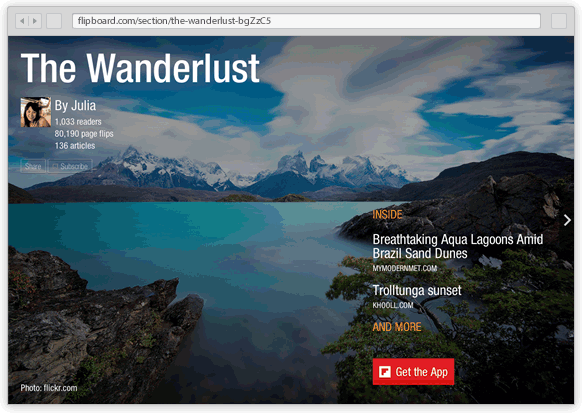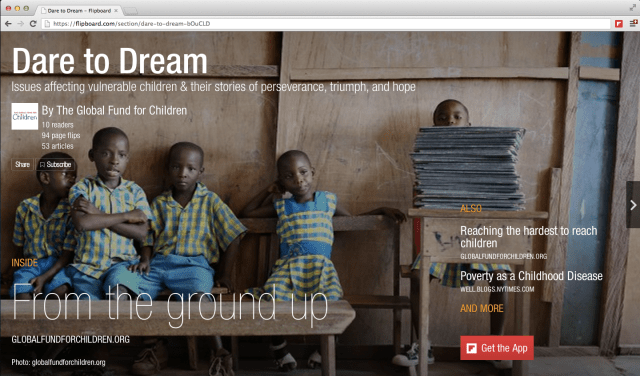Flipboard started on mobile devices, but the magazine app is moving to the web today with the launch of a new site. Its 75 million registered users will be getting access to its superior formatting and curation features for articles, photos and video on their desktops and laptops.
But why the web?
The company has already added 25 million registered users since launching a do-it-yourself mobile magazine creation tool in late March, for a total of around 75 million people to date. If it stayed mobile-only instead of becoming mobile-first — a decision many tech entrepreneurs are considering these days — it would probably continue to grow just fine.
The answer is that the web is still core to how many users behave, particularly around features like easy-access share buttons for distributing articles across social networks and email. If you click on a Flipboard link that you see from a friend on Twitter, for example, you’ll now open a dynamic web page instead of being directed to the mobile app like you would had been before (ex: here’s our TechCrunch Weekly magazine of our top stories, updated every Friday).
Browsing is also at least as easy as the touch interface offered on Flipboard’s iOS and Android native apps, courtesy of Charles Ying and others working on the HTML5 experience for the company. You can use your mouse, magic mouse or trackpad to quickly flip left or right through the stories. If you have a clickwheel, each click turns a page. A navigation scrub bar at the bottom of each magazine lets you quickly browse through the compilation.
“It doesn’t matter if the web site cannibalizes native app traffic,” founder Mike McCue says about the web version. “We don’t care where the user comes from. We’re trying to curate awesome content on any device, as optimized as possible.”

Beyond distribution and a better user experience, being web friendly fits into the Flipboard business plan. The company has begun selling full-page ads mixed in with regular content like what you might see in a high-end print magazine. Larger professional publishers, including the owners of this publication, currently have revenue-sharing agreements in place for their own magazines, but the company plans to expand that to other content and curation creators.
About 2 million magazines have been created since the March launch of the DIY tool, and many of the top ones are being curated by enthusiasts rather than pros — photography, maritime shipping, beer, and GIFS are some example themes. There’s a lot of additional reader attention to sell against.
But what about the publications trying to figure out their online (and mobile) business models? Why should they want Flipboard to get a piece of their precious few remaining ad dollars via alternative destinations like native apps and now its own web links?
For some of them/us, the answer is going to be that they don’t have the resources to build good websites and mobile apps anyway. For others, it’s that they can build their own products but don’t know how to monetize them well.
And for the publishers who have figured out web and mobile design *and* monetization, Flipboard has another answer. You’ll be able to adjust your administrator settings to decide how Flipboard links behave, McCue tells me. If you don’t want them to go to the company’s pages, you can set them to resolve straight to your home site URLs and keep the ad revenue and maybe subscription funnel intact.
He hopes, however, that the Flipboard ad format will appeal so strongly to so many advertisers that they’ll eventually be spending money more like they did in the golden age of print and less like they do on web and mobile publishers these days.
Professional-grade content has generally not been something that Silicon Valley types want to take bets on, so it’s unusual (and pleasant) to see a company led by a veteran tech entrepreneur and backed by top investors working on solutions to our product and monetization problems.

Flipboard also has another launch today, a nonprofits section featuring topical magazines curated by Doctors Without Borders, UNICEF and the Larry King Cardiac Foundation among others. You can find them all via a red ribbon inside the Flipboard interface under the “Big Ideas” category.
The new web versions are supported by the latest versions of all the main desktop and mobile browsers, including IE9+, Safari, Chrome and Firefox, and are offered in 11 languages, including English, Chinese, French, German and Japanese.
